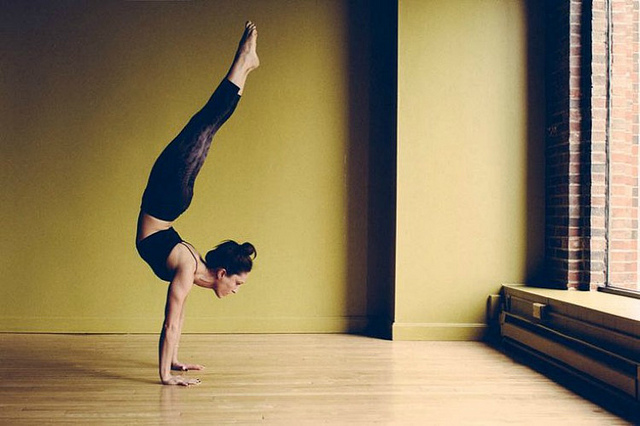“Where love reigns there is no will to power, and where the will to power is paramount, love is lacking.”
~ Carl Jung
A few months back, on a picture-perfect beach in the Maldives, a friendly surfer challenged my yogic bliss.
We were lounging in the sand, discussing travel plans post-Maldivian paradise, and I mentioned that I would be going to India to study yoga.
I love yoga! I beamed, in that cult-like way we yogis sometimes do.
His face transformed into an amused smirk.
A traveling yogini from Southern California.
Did I practice in a sweltering room to party music? Did I have a subscription to Yoga Journal? Was my Facebook profile picture one of me doing dancer pose on the beach?
He described to me a YouTube video he had seen in which a comedic Gandhi visits a modern yoga class and proceeds to be horrified by how badly the ancient practice has been commercialized. He predicted that my trip to India would be fraught with white people in expensive workout clothes trying to find themselves.
I had to laugh and agree with him—to an extent. What most of us experience as yoga in western countries bears little resemblance to yoga in its traditional, Indian beginnings.
But there was something about the conversation that didn’t sit right with me. Something that felt uppity, or even spiteful. A taste of that dangerous territory in which making fun of other people feeds the illusion that we are better than them. Or even that there is an “us” versus “them.”
It certainly wasn’t the first time I had heard from a yoga skeptic, but the proximity of the words to my Indian pilgrimage caused me to linger on them a bit longer. It was a hairline fracture, but these things have a way of spreading, and spread it did. I noticed more and more that even many yogis are yoga skeptics, judging practices that differ from their own.
Like many things that bother us, it led me to dig deeper, and eventually arrive at a realization of sorts. It turned out to be more a contemplation of the heart than the mind.
And this is where my heart led me:
It’s a beautiful thing when ancient traditions evolve into modern practices—practices that open us up to love and enhance us as human beings.
This guy was a surfer (and I am a surfer myself), so I mulled things over in this context.
The way yoga is practiced by many people in modern times has changed, this is true. But so have most practices that have old roots, including surfing.
In ancient Hawaii (where surfing was born), some of the grandest boards were 20 foot wooden behemoths, while modern surfers tend toward small, maneuverable wisps of foam and fiberglass. In ancient Hawaii, surfing was surrounded by religious ritual, yet if a modern surfer picks up his board at the local surf shop, instead of placing a red kumu fish in the mesh of tree roots from whence the board came, people generally don’t quip that he’s not a real surfer. The use of leashes to tether surfers to their boards didn’t reach popularity until the 1980s, which makes them brand new relative to surfing’s beginnings. Yet almost all modern surfers use leashes.
The details and mechanisms change, but the essence of surfing, that ethereal connection with the ocean, remains constant.
So it is with yoga.
Yoga practiced in a modern studio, with or without music, in any brand of clothing, can still be just as authentic as if it were practiced in a quiet ashram. It is what we make of it. The same bliss that ancient gurus have found is available to us wherever we are standing, just as the joy of the ancient Hawaiians is available to a 21st century surfer ripping on a short board.
If we have connected with our breath, we have practiced yoga. If we have chosen love over power and control, we have practiced yoga. If we have stilled the chaotic tumble of thought, found a moment of balance, let go of a fear, we have practiced yoga. These are not things that we can see when we look at one another; these things happen inside, which is where we are if we are practicing yoga.
I believe that if Gandhi were in a modern yoga class, this is what he would say: nothing. Because he would be too deep in his own practice to be looking around at what everyone else was doing.
Maybe we have a hard time accepting variations on yoga because we’ve missed what it’s about to begin with. Of course, it’s not just the physical asana practice, but that’s often the stepping stone that leads people down a yogic path. It’s not about mastering arm balances and using images of them for social media prowess, but it is about revealing ourselves to ourselves—imperfections and all.
We have to catch a glimpse of our ego-driven behaviors before we can know they are there and let them go. And we repeat this cycle again and again, because we are humans; we are never finished.
It all comes down to one of the most simple ideas behind mindfulness: non-judgment. We don’t know what someone else’s experience is, and the beauty in being unique humans is finding our own unique way.
Judging what other people are doing is a controlling act, not a loving one. It’s an expectation that everyone else should think and operate as we do. There’s no freedom or peace in this.
It’s true that there is a growing concern with inexperienced yoga teachers being turned loose to guide classes of inexperienced students, and that teachers are guiding students in ways that could be harmful to them. That’s an instance when it might be our business to offer advice.
But usually, these are not the moments in which we have smug thoughts about others. More often it has to do with what someone is wearing, whether they are “showing off” or “seeking attention,” how loud or quiet they are, how fast or slow they are moving, which variations they are taking on asanas or any number of other things. We judge people who take fast-paced, heated, modern classes for having no idea what real yoga is. We judge people who practice in a slower, quieter, more traditional way for being hippies or putting on a spiritual act.
It’s all surface level observation. No view of the heart.
We have to be mindful of teasing out the true motives behind our judgments: whether we are bothered by something because it is actually harmful, or only because it is different than how we would do it.
Better to engage with the practices that work for us, walk away from the ones that don’t and let everyone else continue on their own journey. What is authentic for one person may not be for another. Getting on board with this reality allows all of us the space to grow.
A teacher who came into my life this past winter in India spoke this truth to our group of students:
“Enlightenment is not to go off into the Himalayas and live in a cave, but to blossom in each and every field of your life.”
We blossom in our own time, in our own way. So, there is no one way that a yoga practice should look. There are no immovable regulations about how to follow a yogic path. It can happen anywhere; it can lead us anywhere.
Yoga is about love, and love grows from the inside out.
I have come to prefer practicing alone, slowly, in a quiet space, maybe somewhere outside. Others might be flowing to Jay Z down the road at a popular studio. Still others are planking on paddle boards out in the water. Others are meditating—maybe on a meditation cushion, or maybe in their parked car.
I’m following my path each day; others are following theirs.
The more we learn about yoga, the more apparent it becomes that this studentship is lifelong. Better to stay curious about what we can learn from those who practice in different ways, than stagnate in yoga policing.
We never know when our certainties are going to be uprooted, so it’s best not to get too attached to them in the first place.
Many of us love the idea of being the change we want to see in the world, but get distracted by being the ego who wants to control the world. We are human, so some of this behavior is inevitable. But as yogis, part of our path is to notice—and then to let go of that which no longer serves us.
On another beach on another day, I met another friendly surfer. We chatted about all things travel, surfing and, yes, yoga. She wasn’t a skeptic, and we met to practice together one morning by the sea. At one point she turned to me, smiling into the morning sun, and made a comment so completely opposite to the ones I had been mulling over that it hit me like cool rain on a hot day:
“Any day that you get to practice yoga is a magical day.”
That’s it. No qualifications. No conditions.
Such simplicity. We have only to practice, however that looks for us at any point in our lives, and listen to see what we can learn.
If we believe in something, let’s live it in the inimitable way that only we can. Let’s follow the beating in our own chest, and trust those around us to do the same. Breathe and let go. Honor that which we don’t yet understand. Choose love. Again and again and again.
Can I get a namaste?
~
Relephant Read:
“Real Yoga” Revealed.
~
Author: Chrissy Tustison
Editor: Toby Israel
Photo: terri_jane / Flickr
~







Read 0 comments and reply